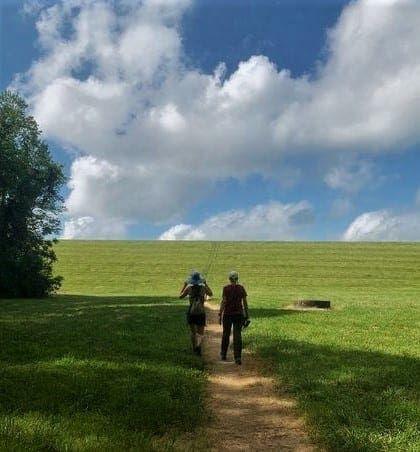Most recently updated January 18th, 2022
Estimated Reading Time: 12 minutes
Training back to your “normal” fitness level after an injury or illness can be very discouraging.
It’s especially devastating if you’d been training towards a specific goal, like a race or an epic hike.
I’m currently training back from illness/injury for the third time this year. Ugh!
But it sure beats not being able to work out at all.
So, just in case you’re new around here, I’ve been spending 8 weeks training (again!) for a specific amazing hike.

Last time, I did this training to hike the Tongariro Alpine Crossing in New Zealand.
The hike was wonderful!
I just managed to squeak that trip in very early last Spring before travel was suspended due to the COVID-19 pandemic.
So this time, I’m training for an amazing hike in Kauai.
This trip has already been rescheduled twice due to COVID travel restrictions.
But even if the hike has to be cancelled again, training as if it’s going to happen will get me back in great shape 🙂
While I’m very impatient with it, I’ve found that it’s possible to do meaningful training while you’re still recovering from injury without pushing yourself too far, too soon.
It’s always good to have a plan! 🙂
This page contains affiliate links. If you make a purchase through an affiliate link, I will receive a small payment at no additional cost to you. I do not get paid for recommendations, all opinions on this site are my own. See full Disclosure page here.
As the Brits say, “Softly, softly catchee monkey!”

Okay, the saying’s a little foreign to us – as it should be, since it originates in a proverb from Ghana, West Africa.
But the meaning is universal.
It’s important to give your body enough time to heal before getting back into full training mode.
Your comeback game-plan should include these steps:
1. Get Your Doctor’s Okay
Are you ready — really?
At a minimum, you shouldn’t return to your sport or activity until the pain, swelling, and stiffness have improved a lot.
Starting back too soon could make your recovery take longer or make your injury worse, so if you’re seriously injured (and not just out of shape) be sure you get the green light from your doc.
I saw my doc right away, and then a couple of weeks after my leg injury.
On his advice I had laid off hiking, but I’d been trying to sneak in some kickboxing, and asked him if that was okay.
“Well, how did it feel?” he asked.
I told him it hurt – and he said that was my answer 🙁
Sometimes “No pain, No gain” isn’t accurate.
Sometimes, pain doesn’t mean that you should give up, but maybe you should take a break or do something else for a while.
You’re the only one who can know when it’s time to take a step back.
2. Mental Prep
You might be avoiding getting back into training because of fear, or discouragement about how strong and fit you used to be – but aren’t right now.
To overcome your fear, before you dive back into training, think about what caused your injury.
Is there anything you could do to avoid it the next time around?
-
- Focus on staying positive! Remind yourself that most injuries are temporary, and it’s just going to take some time to regain the speed and strength you had.
- Forgive yourself for being out of shape. One good thing about “remedial” training is that you already know you can reach your goal, because you’ve done it before!
3. Overcome Your Obstacles
We all have obstacles to exercising.

It might be a tangible thing like an injury, lack of exercise space, or a busy schedule. These are usually pretty easy to deal with.
Or it could be something more internal, like a lack of confidence or motivation – maybe as a result of illness or injury.
These kinds of obstacles can be harder to overcome.
Below are some common mental obstacles that interfere with your workouts, and some strategies to overcome them.
Don’t Sabotage Yourself!
Thinking you’ll just squeeze in a workout whenever you have time almost never works – especially if you’re trying to train back from injury.
If you end up having extra time (which never happens) are you really going to spend it working out? Mmm, probably not.
So how do you avoid this self-sabotage?
-
-
- Schedule your workouts ahead of time. Sit down with your calendar and schedule your exercise time. Then plan what you’ll do during that time.
- Prepare for your workout. Organize everything you need for your workout: clothes, snacks, water, etc., the night before. If you do morning workouts, put them next to the bed, otherwise throw the stuff in a bag to be ready to grab and go.
- Make it easier to exercise. Choose activities that don’t require too much prep or equipment, and join a gym (or find a trail) that’s on your way home or to work.
- Be flexible. Many people have rules about workouts and if even one thing isn’t perfect, they might skip it. If your planned workout doesn’t fit, change it until it does.
-
Going It Alone

Some people really need support from a buddy to get them going – and you might benefit from that, too.

Finding Motivation
Even the most devoted exercisers don’t always feel like getting out of bed at 5:30 for a workout.
Ask anybody if they’re really motivated to get up in the dark to go to the gym and they’ll probably say no.
So why do they do it?
There has to be some kind of reward they’re getting out of that early morning workout.

Maybe that reward is feeling good, meeting a goal, or “earning” a beer after work.
It sounds simple – give yourself a reward and you’ll start exercising. But if that were the case, everyone would be doing it.
So it’s not just the reward…
What really gets you out of bed is a combination of habit, discipline, and persistence.
So how do you get that? The real secret lies in your brain.
What Is a Habit?
A habit is a behavioral pattern we perform repeatedly and consistently.
You probably already have hundreds of habits, from how you get ready in the morning to how you fold your laundry.
The more often we do them, the deeper these actions are embedded in our brains.
You don’t have to think about the hundreds of movements that go into driving a car – get the keys, open the door, sit down, put on your seatbelt, etc.
The only way to make those behaviors automatic is by doing them over and over so you don’t have to think about them anymore.

For years, I would get up and exercise every morning before 5am.
The time constraints actually helped me stick with it, because it was a “now or never” situation every day.
In recent years, working from home – and the kid growing up – has made me more of a slacker 😉
Build Your Exercise Habit
There are two other things – besides repetition and a reward – that you need to make a habit work, especially with exercise:
-
- A craving for the reward and
- The belief that you can actually do the workout you’ve planned.
Rewards for exercise could be feeling good, craving the endorphins released during exercise, or getting a sense of accomplishment.

You Need “Believement”
Another necessary ingredient to your success is believing you can do it!
You need to have the belief that you can plan your workouts, and complete them.
That confidence doesn’t just happen, you need to approach your fitness goals in the right way.
Make Your Habit Stick
Working out involves a bunch of small behaviors, including:
-
- the planning that goes into your workouts,
- the prep time of getting your exercise gear together, and
- the real work of getting up, driving to the gym, and doing your workout.
Added up, it’s a lot when you aren’t already doing those things.
That’s one reason many people can’t stick with an exercise habit, even though they want to get fit or lose weight. So, how do you do it?
1. Plan Your Cues
Studies of successful exercisers find that what works is choosing a very specific cue. A cue is a kind of ritual that triggers your brain to think, “Its time to exercise.”
Some exercise cues might be:
-
-
- Schedule exercise on your calendar – Putting a workout on your calendar will remind you to bring your gym bag and also makes it feel more like a commitment.
- Change into workout clothes as soon as you wake up or get home from work.
- Pre-workout ritual – Drink a glass of water, choose some music, or do some stretches.
-
Sometimes just doing that one thing can put you in the right frame of mind.
Now let’s look at other cues that might be triggering your urge to skip your workout.

Some possibilities:
-
-
- Hitting the snooze button instead of working out.
- Sitting on the couch when you get home (instead of getting into workout clothes).
- Spending your workout time on social media
-
Just like you have a habit of sitting on the couch, you can create a new habit of exercising by creating ways to avoiding those lazy cues:
-
-
- Move your alarm across the room, so you have to get up
- Change into workout gear at work
- Stream a podcast while you walk/run instead of sitting and scrolling.
-
2. Plan Your Comeback
This is the critical part – and often where we make our biggest mistakes.
Because we’re so eager to get back in shape, we tend to go too far with our comeback workouts.

Start With the Familiar
If you’re coming back from a layoff or injury, you also need to plan your workouts to begin with something you can do now and gradually work your way back to full strength.
Remember, one of the key ingredients to making exercise a habit again is the belief that you can and will do it.
Here are some ways to help you trust yourself to follow through.
3. Start Simple
The best workout each day is the workout that you will do.
Creating a simple workout you’ll do, even if you’re tired or low on motivation – and even if that workout isn’t even close to the exercise you want to end up with – is sometimes the best thing for you.

Here are some simple starters:
-
- 5-Minute Walk – Set a goal for just 5 minutes every day. Chances are you’ll keep going a little longer than that.
- Quick and Easy Bodyweight Workout – This workout includes 3 simple exercises that focus on building a strong core – situps, pushups, and squats. 3 sets of 10-15 to start with.
- Jumping Jacks or Jump Rope – Add some easy cardio with 5-10 minutes of jumping rope or jumping jacks.
Whatever you do, do something every day – and take it from there!
3. Plan Your Rewards
Some of the rewards of exercise come naturally.
Just completing a workout can feel good and, if you’re consistent you’ll start to crave that feeling.

You can also create your own rewards such as:
-
-
- A guilt-free hour of TV
- A glass of wine with dinner
- A new workout outfit
- A new book to read
-
The point is to reward yourself every single time you workout.
Secure Your Exercise Habit
Getting started is often the hardest part, so the easier you can make that, the more successful you’ll be.
Here are some ways to do that:
-
- Try doing your workouts at the same time every day.
- Track your progress. Mark every workout on your calendar.
- Focus on the habit first, then the results.
Too often we’re so focused on reaching a goal that we end up quitting when it doesn’t happen soon enough.
So, when you’re just starting out, choose activities that you like, keep your workouts simple and focus on just showing up.
Put on Your Perspective Pants
It’s been more difficult than I thought it would be to go back to my usually pretty Spartan eating habits and disciplined training routine.
Over the past few weeks, along with focused remedial physical training, I’ve also been trying to clean up my diet.
Because of my asthma, years ago I adopted a “clean” diet ( you can read about my Anti-Asthma Diet here ) that focuses more on protein and veggies, and less on dairy and grains.
Being forced to exercise less has – understandably – caused me to gain some weight as well as lose strength, and cardio fitness.
So now, in addition to being less fit than I was before injury, I’m also anxious about being “too much of a good thing” 😉
When this happens, I try to take a deep breath and put on my Perspective Pants.
Seriously, these are actual pants.
They were my favorite hiking pants a few years ago, when I was in pretty good shape and the weight I wanted to be.
(This is also apparently a book series – which I didn’t know until just now.
Click the image to learn more.)
Anyway…..
My pants got torn, and I put them away with my sewing stuff to mend later – which of course never happened…
I found the pants again a couple of months ago when raiding my fabric stash to rig a face covering, and on a whim I tried them on.
Guess what? I’m really not that far from fitting comfortably into those pants.
I can’t really trust how I look to myself in the mirror, or how I think I’m doing on the trail.
When I’m doing remedial work, I also can’t really know when I’m done without some sort of mental finish line.
It helps to have an objective measure of progress or success – so you know when you’re done!
Whether it’s a (non-stretchy) clothing item or a timed hike or run – find some “Perspective Pants” of your own to help gauge where you are on your path to your fitness or weight goals.
You might find that you’re a lot closer than you think! 🙂

I hope this article was helpful if you’re trying to train back from injury, or get back into an exercise habit.
You might try Forest Bathing or Shinrin Yoku as a way to get outdoors without moving too fast, too soon.
You could also take a look at my 8 Weeks to Awesome Training Plan , if you want to see what kind of training I’m doing – over and over, apparently… 😉
Thanks for stopping by – see you next time! LJ
To Get New Idratherwalk Posts
sent directly to your inbox (how convenient!) Click this Button
If you like this post, please share it!


LJ has spent much of her free time as a single Mom – and now as an empty-nester – hiking in the US and around the world. She shares lessons learned from adventures both local and in exotic locations, and tips on how to be active with asthma, plus travel, gear, and hike planning advice for parents hiking with kids and beginners of all ages. Read more on the About page.



If your fitness downfall was illness, injury, or being stuck in a studio apartment for months due to a lockdown, you could be feeling hugely resentful, extra-fluffy and unmotivated.
In my case, (this time) it was a combination of three things:
Seriously, all of those things at once.
I couldn’t train or eat normally for more than 6 weeks!!!!